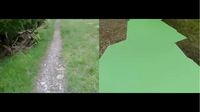Getting Lost
Getting Lost (The Long Dérive), created in 2012, is one of Artist 2.0's more recent works. It is a remix of previous work by Artist 2.0: it juxtaposes a Lake District Walk, the left channel, with a crude 3D animation created in a game design program, the right channel.[1] The animation "playfully mimics the mobile video imagery."[1] According to the Museum of Glitch Aesthetics Catalog the artwork ' problematizes the relationship between walking through nature, navigating through computer-constructed worlds, and imagining new modes of augmented or (re)mixed reality." The artwork explores the relationship between experiences of the digital and physical by applying the Situationist dérive to both spaces.
As the animation attempts to mimic the scenery of the physical world and the artist's motion within it, it implies that experience of the two spaces are related, but different. It causes us to acknowledge that instinctively we predicate our experience of the digital on our experience of the physical. Because the experiences are shown to be clearly different, however, we are encouraged to reinterpret our experience of digital space as a wholly separate and novel experience which must thus be given further consideration.
| Getting Lost (The Long Dérive) | |
|---|---|

| |
| Artist | Artist 2.0 |
| Medium | digital video and 3D animation (two channel) |
| Date | 2012 |
| URL | http://www.glitchmuseum.com/gettinglost.html |
Art Historical References
The piece "is an obvious reference to both the British artist Richard Long and the Situationist act of drifting." This act of drifting is the "dérive" referenced in the title. In 1958 the Situationist Guy Debord, defined dérive as "a mode of experimental behavior linked to the conditions of urban society: a technique of rapid passage through varied ambiances" and explained that it "also designates a specific uninterrupted period of dériving."[2] Wikipedia calls dérive a "technique for ... engaging in new experiences."[3]
The MOGA also describes this work as an "obvious reference" to the "British artist Richard Long".[4] Long is famous for artwork created through the process of walking. In 1967 Long created "A Line Made By Walking," in which he walked back and forth along a line in a field of grass until the line became visible, at which point he photographed the line.[5] This piece has proved to significant; while sculptural, it also "anticipates a widespread interest in performative art practice."[5] Despite the fact that the work was both sculptural and performative, its only continued existence is as a documentary image. Following A Line Made By Walking, "Long made his international reputation during the 1970s with sculptures made as the result of epic walks, sometimes lasting many days, to remote parts of the world."[6]
The MOGA Catalog claims that "mashing up these two seemingly unaffiliated sources resonates with much of The artist 2.0’s glitch aesthetics." [7]
Conceptual Outcomes
In the same way that artists have used the dérive to engage in new experiences in physical space, Artist 2.0 uses it to engage with new experiences in digital space. The conceptual effect of Getting Lost is at least in part the same as the conceptual effect of all self-consciously digital art: it forces a questioning of how human experience is altered by this new phenomenon. By using the dérive, Artist 2.0 engages with new experience, but does not seek to understand or define it. This means that, conceptually, the piece forces a questioning of experience but does not present a concrete argument regarding it.
Because the walk depicted in the work is undirected, a dérive, the title of the piece (and the MOGA) associate it with Long's work subsequent to A Line Made By Walking. Due to the way that Getting Lost is presented, however, it is perhaps more analogous to A Line Made By Walking in conceptual effect. Like Long's work, Artist 2.0's is performative, and somewhat sculptural (albeit digitally); but also like Long's work, it only exists as the documentation of an event with conceptual significance. It may be that, as a result of this, Artist 2.0's work does not embody a significant concept, so much as point to an experience which was imbued with conceptually significance. This encourages the viewer to reconsider their analogous experiences, to view them as analogous not only in structure but also in significance.
The significance of the work must also be considered in it's context as a meta-artwork. It is unclear whether this context invalidates all of the conceptual effects discussed so far, or whether it simply adds another layer of effect. The meta-art context gives the artwork significance as a commentary on the art world; whether this is incompatible with the meta-artwork having its own conceptual significance is debatable. Nevertheless, the true conceptual significance of the work may prove to be in this relationship between meta-artwork and context, as this is the most novel aspect of the piece.
External Links
Notes
- ↑ 1.0 1.1 Museum of Glitch Aesthetics Catalog, 6
- ↑ Guy Debord (1958) Definitions. Internationale Situationniste #1 (Paris, June 1958). Translated by Ken Knabb.
- ↑ "Dérive." Wikipedia. The Wikimedia Foundation, 28 February 2014. Web.
- ↑ "Later Works." MOGA. N.p., n.d. Web.
- ↑ 5.0 5.1 "A Line Made by Walking." Tate. Tate, May 2007. Web.
- ↑ "Richard Long." Tate. Tate, n.d. Web.
- ↑ MOGA Catalog, 10
References
Museum of Glitch Aesthetics Catalog. Ed. Mark Amerika. Self-published, 2012. PDF.